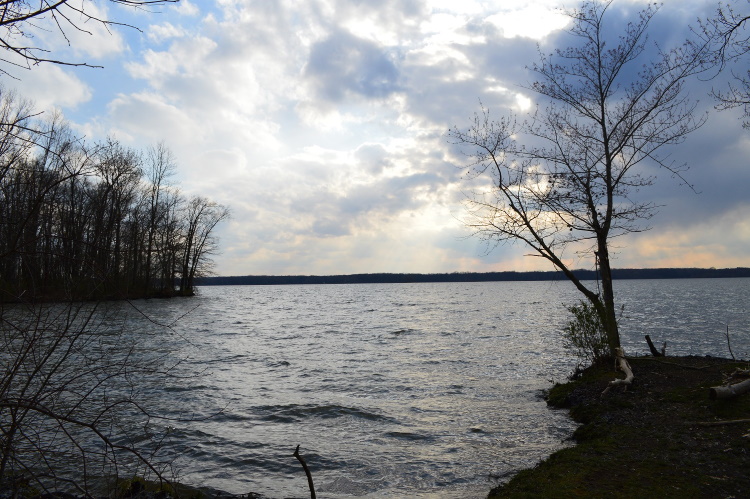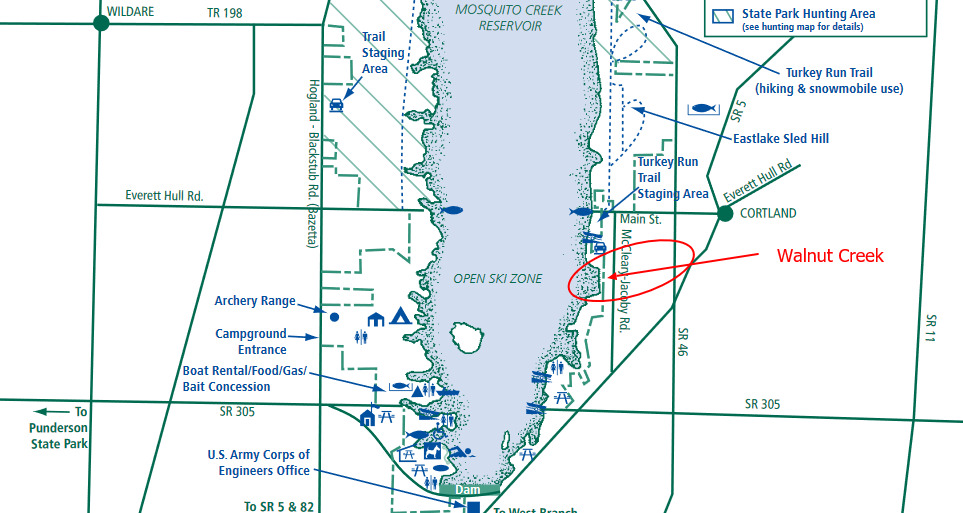Mosquito Lake SP--Walnut Creek

Mosquito Lake SP--Walnut Creek
Cortland, Ohio 44410
Mosquito Lake State Park websiteMosquito Lake State Park map
Mosquito Creek Lake (US Army Corps of Engineers) webpage
Mosquito Creek Lake brochure
Mosquito Creek Lake map
Also, see all the hotspots at:
Mosquito Creek Corridor Important Bird Area
About this Location
Walnut Creek flows out of Cortland and enters Mosquito Lake just east of a bridge on McCleary Jacoby Road. The creek waters mix with lake water in a small cove east of the bridge, where Belted Kingfishers can frequently be seen, along with herons, Mallards, and Wood Ducks.
The Ohio Department of Wildlife manages a property southwest of the bridge extending out to the lake, which is best for walking while birding. The property extends south for about 300 yards from the bridge along the road, and west out to the lake for about 200 yards. There are no trails here; however, the grass is mowed from the gravel parking lot to the lake and the northern point.
In early 2020, the Department of Wildlife installed two Osprey nest poles on this property, and five around the lake. One is located halfway out to the lake, which can be seen from the parking lot; and one at the furthest northern point is located about 250 yards out.
Birding is safest on the grass path out to the lake, which is never narrower than 20 feet across. The Eastern Phoebe and Brown Thrasher have been found here. The Prothonotary Warbler nests naturally between the grass strip and the lake on the north side. Other warblers migrating along the east side of the lake can be found as well as migrating ducks and loons.
A scope can be set up looking west out across the lake, north, and back towards the bridge from the point. There are trees and shrubs along the shoreline directly west; with a few openings for those fishing or with a scope. There are some openings looking southwest. The woods to the south have a deer path, but many plants with thorns exist here. Along McCleary Jacoby road from the parking lot headed south, there is no ditch and about six feet of level ground beside the property; otherwise, it is mostly lined with multi-flora rose. The southern property boundary ends at a fence for a Yacht Club.
There are no facilities at this property; not even a bench or picnic table. The closest public facilities are south at the OH-305 Boat Launch.
About Mosquito Lake State Park
See all hotspots at Mosquito Lake State Park
Before Ohio was settled, the banks of Mosquito Creek were hidden by a vast forest that covered most of the state. Little remains of the ancient forest that stood for nearly 10,000 years. In the Mosquito Lake area, regrowth has occurred and the nice stands of beech-maple woodlands can be enjoyed. In pioneer times, the beech-maple belt was very extensive and stretched from Mansfield to Pennsylvania. The reason is that this area has more cloudy days, cooler summer temperatures, and more winter snow cover as compared to the rest of Ohio.
The park’s woodlands support colonies of spring beauties, anemones, Dutchman’s breeches, purple cresses, and other spring wildflowers. Goldenrod and asters will bloom in the fall in the park’s open areas. Many wildlife species find the park’s varied habitats suitable. Red fox, woodchuck, muskrat, beaver, fox squirrel, raccoon, rabbit, and white-tailed deer are common. Recently, river otters were reintroduced in nearby favorable locations. Several otter families have been sighted.
Many birds live in or migrate through the area including robins, warblers, swallows, and sparrows. The yellow-bellied sapsucker and hairy woodpecker are uncommon in other parts of Ohio but abundant in this part of the state. Numerous species of waterfowl and shorebirds take advantage of the park’s many wetlands during spring and fall migrations. Canada geese, herons, tundra swans, great egrets, and a variety of ducks can be observed. Large predatory birds including several species of hawks and the magnificent bald and golden eagles have been spotted here.
Features
Restrooms on site
Wheelchair accessible trail
Entrance fee
Roadside viewing
Content from Rick Nelson, Ohio Ornithological Society, and Mosquito Lake State Park webpage

